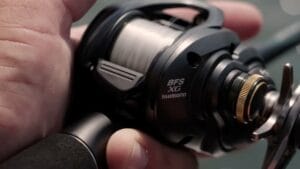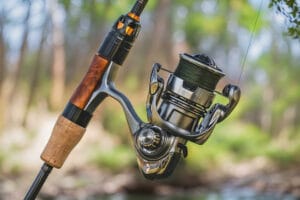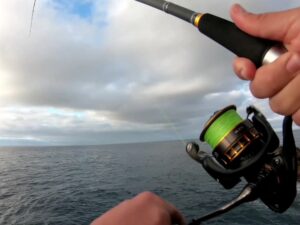Fishing gears are at the very heart of a fishing reel. You can improve your fishing experience if you use a proper bait casting reel with the right gear ratio.
Baitcasting fishing reels are one of the most common types of fishing reels. They are mainly used for sport fishing. These reels are characterized by a rotating arm that is connected to the spool by a shaft known as a control at the base of the reel.
A casting reel can be found in many sizes and designs. The ideal reel will hold the maximum amount of line and have the right amount of resistance to let you know you’ve hooked a fish.
Selecting the right gear ratio is important. The gear ratio is found on the box. It is written as a set of two numbers that are separated by a colon. These numbers provide you with the information you need to know how many times the spool rotates per turn of the handle.
A low gear ratio will increase the number of turns per cast, whereas a high gear ratio will decrease the number of turns.
A low gear ratio is suitable for slow reeling, while a high gear ratio is suitable for fast reeling.
However, if you want to use your reel to cast heavy baits, then you should choose a lower gear ratio reel. The gear ratio usually ranges from 7.1:1 to 5.4:1 for baitcasting reels, though it could be higher and lower.
Understanding Gear Ratios
The gear ratio of a reel affects its ability to retrieve line, while the spool of a reel affects how much line can be retrieved per turn. Due to advances in technology, reels are now faster, smaller and more efficient, reducing fatigue and improving fishing efficiency.
This is accomplished by reducing the size of the frame, increasing the size of the spool and working the drag system to make it faster and more secure All this results in higher gear ratios that offer greater speed and distance in retrieving line.
Finding the Right Gear Ratio for the Job
Fishing reels work because of their gear ratio. Fast reels will generally have a gear ratio about 7:1, medium reels will be in the range of 5:1 to 6:1, and slow reels will have a gear ratio below 5:1.
In the early days of tournament fishing, 7:1 reels were not durable enough to stand up to long-term fishing, but as technology has advanced, gear ratio speeds have increased. This means you can use a fast reel for medium and light techniques and a medium reel for medium and heavy techniques.
Fast reels have become common for light techniques because they have the ability to cast 20-plus feet of line with minimal effort. Medium reels are good for fishing medium distances with average head weights. For heavy techniques, slow reels are good because the slower gear ratio provides you with a higher degree of torque.
Applications Requiring a Low Gear Ratio
Slow reels with a gear ratio of up to 5:1 are often the right choice for fishing big swimbaits, slow-rolled spinnerbaits, and deep diving crankbaits. Slow reels have a gear ratio that allows the bait to remain in the strike zone during the entire cast.
What’s more, a slow gear ratio allows you to cast a heavy line and leader, resulting in the ability to fish for the biggest fish. Slow gear ratios will also enhance your fishing experience if you intend to use a straight-line jerkbait, such as a Zoom Super Fluke.
Applications Involving Medium Gear Ratios
Medium reels with a gear ratio range from 5:1 to 6:1 are suitable for fishing medium to light baits. They are great for spinnerbaits, crankbaits with square bills, medium-depth crankbaits, and umbrella rigs that can be fished at a comfortable speed.
However, choosing a medium gear ratio does not have to be a daunting task. A simple rule of thumb to remember is that when the water conditions are tough, select a medium gear ratio reel.
Applications Involving Fast Gear Ratios
Fishing quickly with fast gear reels is a solid way to catch fish with Texas rigs, topwaters, jerkbaits, jigs, big worms, lipless crankbaits, and Carolina rigs.
Anglers who use worms have the advantage of reeling in their bait faster so that they can fish for a longer period of time.
Fast reels enable better hooksets when jerking or moving quickly, and aid horsing bass in getting out of heavy cover. It’s important to use the proper reel for the job, as it will have a profound impact on the performance of your fishing.
Make the Most of Your Strengths
Although you may choose different types of low profile or conventional casting reels for different fishing techniques, you are still able to use one baitcasting reel for many different applications. Choose your casting reels based on their strengths.
For instance, if you use topwaters covered with a heavy skirt, with your drag set up and ready to run, you’re going to be more comfortable using a reel with a 7:1 ratio. On the other hand, if you’re using a 5” fluke with a ¼ ounce weight, you’re going to want a gear ratio of 6:1.
Reel Design
The basics of baitcasting reel design are relatively simple. The gears connect the spool to the control, which allows you to retrieve the line You can find 2 main types of baitcaster designs. Lower Profile casters, which are typically tournament reels featuring a round cross-section spool and open spool design. The second are round baitcasters, which are generally larger, feature an open face level spool and are mainly used for trolling and open face reels are mainly used for reaction baits.
Conclusion
Choosing a gear ratio for your baitcaster is not that difficult as long as you keep in mind the applications that reels are used for, their gear ratio and design. You need to take into consideration all of these factors to be able to choose the right gear ratio for your baitcasting reel.




